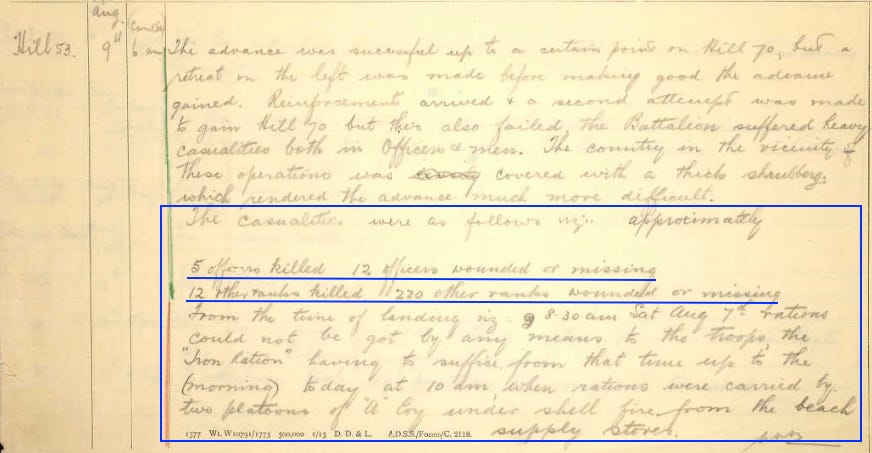Niblock - Wartime Service (Gallipoli)
According to the 6th Royal Irish Fusiliers unit diary, Hugh Niblock’s battalion received orders to sail to the Dardanelles strait in Turkey on 9 July 1915. They left Basingstoke, England on 14 July, arrived in Malta on the 21st, Alexandria on the 24th, and then arrived in Mudros (on Lemnos island) on the 27th. Other units aboard the ship disembarked, but the 6th Battalion continued on to Mytilene on 31 July. The diary reports that the unit was comprised of “27 officers including Medical Officers + Chaplain…6 Warrant Officers + 756 Other Ranks.”1 They then sailed once more for Salt Lake Bay in Gallipoli and into action in early August 1915.
When they arrived on the morning of 7 August, they were immediately “subjected to heavy shrapnel fire” as they attempted to land. According to the unit diary, “the Battalion went into action about 650 strong…+ during the day suffered the following casualties: 1 officer wounded, 12 other ranks killed & 76 other ranks wounded + missing.”2 ‘Other ranks’ referred to non-commissioned officers and below, usually sergeants down to and including the rank of private.
Over the next several days, the battalion’s numbers were depleted significantly. An advance on 9 August “was successful up to a certain point,” but their attempts to take the high ground (held by the Ottomans) were hindered not only by shrapnel and rifle fire but also by the difficult terrain. Making matters worse, the heavy fire prevented the men from receiving rations: “From the time of landing viz 8:30am Sat Aug 7th rations could not be got…the ‘Iron Ration’ having to suffice from that time up to the (morning) today at 10 am.”3 By the end of the day the battalion had lost hundreds of fighting men: 5 officers killed and 12 wounded or missing; 12 other ranks killed, and 220 other ranks wounded or missing.
They were pulled back to rest in reserve for several days before returning to the line on 15 August, already reinforced by 5 new officers and 159 other ranks sent from Mudros because of the battalion’s heavy losses. On the morning of 16 August they were forced to fall back due to “rapid rifle fire” and “bombardment of hand grenades + bombs.” By noon of the same day, they “returned to support trenches having lost approximately (killed, wounded + missing) 10 officers + 210 other ranks.”4
While in support trenches on 1 September, the unit diary recorded that the total battalion strength had been reduced to only 5 officers and 388 other ranks, a significant decrease from the original 27 officers and 756 other ranks who had landed in Gallipoli less than one month before. Throughout September the battalion alternated between support and reserve trenches; despite some enemy artillery and sniping, the casualties were low. The officer keeping the unit diary noted that the men had set up a gong to warn their comrades of enemy shelling and allow them to take cover:5
The battalion was removed from Suvla Bay in Gallipoli and returned to Lemnos on 30 September. The only entry for 1 October (scratched out by the writer, as the entry should have been in a separate volume for the new month) reports that, “with the exception of fatigue [working] parties, the Battn [battalion] was given a complete rest, the men appearing to be exhausted.”6
Captain Noel Drury’s personal diary described the same, reporting on 3 October 1915 that “I had a long deep sleep, not moving for 12 hours. The extraordinary quiet of everything was quite uncanny at first after the noise of the [Gallipoli] peninsula.”7 And again, two days later, he pessimistically considered the division’s odds if sent into battle against the Bulgarians: “If we have to fight the Bulgar, as some say we will, I think that we will probably get it in the neck, as they are all fresh and ready while our fellows are worn out and tired.”8
“UK, World War I War Diaries (Gallipoli and Dardanelles), 1914-1916,” 31 July 1915, Piece 4296: 31 Infantry Brigade: 6 Battalion Royal Irish Fusiliers (1915 Jul-Sep), Ancestry.com.
“UK, World War I War Diaries (Gallipoli and Dardanelles), 1914-1916,” 7 August 1915, Piece 4296: 31 Infantry Brigade: 6 Battalion Royal Irish Fusiliers (1915 Jul-Sep), Ancestry.com.
“UK, World War I War Diaries (Gallipoli and Dardanelles), 1914-1916,” 9 August 1915, Piece 4296: 31 Infantry Brigade: 6 Battalion Royal Irish Fusiliers (1915 Jul-Sep), Ancestry.com.
The ‘iron ration’ referred to emergency rations issued to soldiers for situations when regular rations could not be distributed. For an example, see “Iron ration in sealed tin, 1915,” NAM. 1959-05-63-1, Soldier gallery, National Army Museum. https://collection.nam.ac.uk/detail.php?acc=1959-05-63-1.
“UK, World War I War Diaries (Gallipoli and Dardanelles), 1914-1916,” 16 August 1915, Piece 4296: 31 Infantry Brigade: 6 Battalion Royal Irish Fusiliers (1915 Jul-Sep), Ancestry.com.
“UK, World War I War Diaries (Gallipoli and Dardanelles), 1914-1916,” 18-21 September 1915, Piece 4296: 31 Infantry Brigade: 6 Battalion Royal Irish Fusiliers (1915 Jul-Sep), Ancestry.com.
“UK, World War I War Diaries (Gallipoli and Dardanelles), 1914-1916,” 1 October 1915, Piece 4296: 31 Infantry Brigade: 6 Battalion Royal Irish Fusiliers (1915 Jul-Sep), Ancestry.com.
Diary of Captain Noel Drury, 6th Battalion The Royal Dublin Fusiliers, October 1915 to July 1916, 3 October 1915, NAM 1976-07-69-2, National Army Museum, London.
Diary of Captain Noel Drury, 6th Battalion The Royal Dublin Fusiliers, October 1915 to July 1916, 5 October 1915, NAM 1976-07-69-2, National Army Museum, London.





